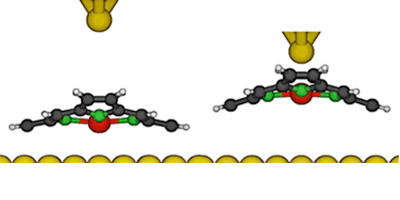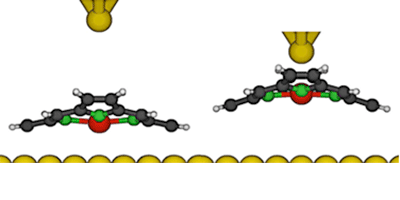Molecular Voltage Shift
Single molecules offer promise as components for nanoscale electronic circuits. Now, experiments with a molecule sandwiched between two metal electrodes show that a molecule’s conductance depends sensitively on its configuration. Sujoy Karan, at the University of Kiel in Germany, and colleagues report that bending the molecule shifts its most resistive portion from one electrode to the other. This effect could be used to engineer a molecular-scale potentiometer, a device whose variable resistance can be used to control the flow of current in a circuit.
The group deposited manganese tetraphenylporphyrin (a large flat molecule with a central metal manganese ion) on a gold surface, which functioned as one electrode. A gold-coated tip from a scanning tunneling microscope was placed just above the molecule and served as both the second electrode and a voltage source. The authors measured the - curve of the molecule—its conductance as a function of voltage—while lowering the tip and observed that the curve’s shape changed dramatically when the tip was within about angstroms of the molecule.
The team explained this behavior using density-functional theory, which allowed them to calculate the coupling between the tip, molecule, and gold substrate at different tip heights. According to their calculations, the tip-molecule gap is the most resistive part of the junction when the tip is far from the molecule. When the tip is close to the molecule, however, it lifts the molecule’s center off of the substrate, and the molecule-substrate contact becomes the point of highest resistance. The tunable voltage drop across each contact could be used to control current in molecular-scale electrical circuits.
This research is published in Physical Review Letters.
–Katherine Wright





